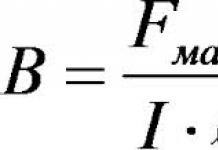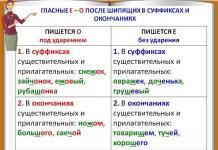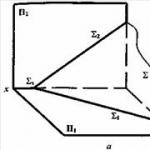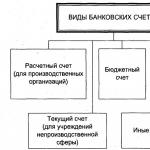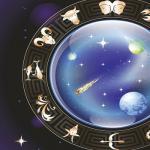Magnetic induction (symbol B)– the main characteristic of a magnetic field (vector quantity), which determines the force of influence on a moving electric charge (current) in a magnetic field, directed in the direction perpendicular to the speed of movement.
Magnetic induction is defined as the ability to influence an object using a magnetic field. This ability manifests itself when moving permanent magnet in the coil, as a result of which a current is induced (occurs) in the coil, while the magnetic flux in the coil also increases.
Physical meaning of magnetic induction
Physically, this phenomenon is explained as follows. The metal has a crystalline structure (the coil is made of metal). The crystal lattice of a metal contains electrical charges - electrons. If no magnetic influence is exerted on the metal, then the charges (electrons) are at rest and do not move anywhere.
If the metal comes under the influence of an alternating magnetic field (due to the movement of a permanent magnet inside the coil - namely movements), then the charges begin to move under the influence of this magnetic field.
As a result, an electric current arises in the metal. The strength of this current depends on the physical properties of the magnet and coil and the speed of movement of one relative to the other.
When a metal coil is placed in a magnetic field, the charged particles of the metal lattice (in the coil) are rotated at a certain angle and placed along the lines of force.
The higher the strength of the magnetic field, the more particles rotate and the more uniform their arrangement will be.
Magnetic fields oriented in one direction do not neutralize each other, but add up, forming a single field.
Magnetic induction formula 
Where, IN— vector of magnetic induction, F- maximum force acting on a current-carrying conductor, I- current strength in the conductor, l— length of the conductor.


Magnetic flux
Magnetic flux is a scalar quantity that characterizes the effect of magnetic induction on a certain metal circuit.
Magnetic induction is determined by the number of lines of force passing through 1 cm2 of the metal section.
The magnetometers used to measure it are called teslometers.
The SI unit of measurement for magnetic induction is Tesla (Tl).
After the movement of electrons in the coil ceases, the core, if it is made of soft iron, loses its magnetic qualities. If it is made of steel, then it has the ability to retain its magnetic properties for some time.

We cannot see the magnetic field, but to better understand magnetic phenomena it is important to learn how to depict it. Magnetic needles will help with this. Each such arrow is a small permanent magnet that easily rotates in a horizontal plane (Fig. 2.1). You will learn from this paragraph how the magnetic field is graphically depicted and what physical quantity characterizes it.

Rice. 2.2. In a magnetic field, magnetic arrows are oriented in a certain way: the north pole of the arrow indicates the direction of the magnetic field induction vector at a given point
We study the strength characteristics of the magnetic field
If a charged particle moves in a magnetic field, then the field will act on the particle with some force. The magnitude of this force depends on the charge of the particle, the direction and speed of its movement, and also on how strong the field is.
The strength characteristic of a magnetic field is magnetic induction.
Magnetic induction (magnetic field induction) is a vector physical quantity that characterizes the force action of a magnetic field.
Magnetic induction is designated by the symbol B.
The SI unit of magnetic induction is tesla; named after the Serbian physicist Nikola Tesla (1856-1943):
The direction of the magnetic induction vector at a given point of the magnetic field is taken to be the direction indicated by the north pole of the magnetic needle installed at this point (Fig. 2.2).
Note! The direction of the force with which the magnetic field acts on moving charged particles or on a current-carrying conductor, or on a magnetic needle, does not coincide with the direction of the magnetic induction vector.
Magnetic lines:

Rice. 2.3. Magnetic field lines of a strip magnet
Outside the magnet they leave the north pole of the magnet and enter the south pole;
Always closed (magnetic field is a vortex field);
They are most densely located at the poles of the magnet;
Never intersect
Representing a magnetic field
In Fig. 2.2 we see how magnetic needles are oriented in a magnetic field: their axes seem to form lines, and the magnetic induction vector at each point is directed along the tangent to the line passing through this point.
Magnetic fields are graphically depicted using magnetic lines:
1) the direction of the magnetic induction vector at a given point is taken as the direction of the magnetic induction line;

Rice. 2.4. Chains of iron filings reproduce the pattern of magnetic induction lines of the magnetic field of a horseshoe magnet
2) the larger the magnetic induction module, the closer the magnetic lines are drawn to each other.
Having examined the graphical representation of the magnetic field of a strip magnet, we can draw some conclusions (see Fig. 2.3).
Note that these conclusions are valid for the magnetic lines of any magnet.
What direction do the magnetic lines inside a strip magnet have?
The pattern of magnetic lines can be reproduced using iron filings.
Let's take a horseshoe magnet, put a plexiglass plate on it and pour iron filings onto the plate through a strainer. In a magnetic field, each piece of iron will be magnetized and turn into a small “magnetic needle”. Improvised “arrows” are oriented along the magnetic lines of the magnet’s magnetic field (Fig. 2.4).
Draw a picture of the magnetic field lines of a horseshoe magnet.

Let's learn about a uniform magnetic field
A magnetic field in a certain part of space is called uniform if at each point the magnetic induction vectors are the same both in magnitude and in direction (Fig. 2.5).
In areas where the magnetic field is uniform, the magnetic induction lines are parallel and located at the same distance from each other (Fig. 2.5, 2.6). Magnetic lines of a uniform magnetic field directed towards us are usually depicted as dots (Fig. 2.7, a) - it is as if we see “arrowheads” flying towards us. If magnetic lines are directed away from us, then they are depicted with crosses - it’s as if we see the “feathers of arrows” flying away from us (Fig. 2.7, b).
In most cases, we are dealing with a non-uniform magnetic field - a field at different points of which the magnetic induction vectors have different values and directions. The magnetic lines of such a field are curved, and their density is different.

Rice. 2.6. The magnetic field inside a strip magnet (a) and between two magnets facing each other with opposite poles (b) can be considered uniform
Studying the Earth's magnetic field
To study terrestrial magnetism, William Gilbert made a permanent magnet in the form of a ball (model of the Earth). Having placed a compass on the ball, he noticed that the compass needle behaves in the same way as on the surface of the Earth.
Experiments allowed the scientist to suggest that the Earth is a huge magnet, and its south magnetic pole is located in the north of our planet. Further research confirmed W. Gilbert's hypothesis.
In Fig. Figure 2.8 shows a picture of the magnetic induction lines of the Earth's magnetic field.

rice. 2.7. Image of magnetic induction lines of a uniform magnetic field, which are perpendicular to the plane of the drawing and directed towards us (a); directed from us (b)
Imagine that you are walking towards the North Pole, moving exactly in the direction that the compass needle is pointing. Will you reach your destination?
The magnetic induction lines of the Earth's magnetic field are not parallel to its surface. If you fix the magnetic needle in a gimbal, that is, so that it can rotate freely both around the horizontal and

Rice. 2.8. Layout of magnetic lines of the magnetic field of planet Earth

and around the vertical axes, the arrow will be set at an angle to the surface of the Earth (Fig. 2.9).
How will the magnetic needle be located in the device in Fig. 2.9 near the Earth's north magnetic pole? near the Earth's south magnetic pole?
The Earth's magnetic field has long helped travelers, sailors, military personnel and others to navigate. It has been proven that fish, marine mammals and birds orient themselves according to the Earth’s magnetic field during their migrations. Some animals, such as cats, also navigate when looking for the way home.
Learn about magnetic storms
Studies have shown that in any area the Earth's magnetic field changes periodically, every day. In addition, small annual changes in the Earth's magnetic field are observed. However, there are also sudden changes. Strong disturbances in the Earth's magnetic field, which cover the entire planet and last from one to several days, are called magnetic storms. Healthy people practically do not feel them, but for those who have cardiovascular diseases and diseases of the nervous system, magnetic storms cause a deterioration in their well-being.
The Earth's magnetic field is a kind of “shield” that protects our planet from charged particles flying from space, mainly from the Sun (“solar wind”). Near the magnetic poles, streams of particles fly quite close to the Earth's atmosphere. With increasing solar activity, cosmic particles enter the upper layers of the atmosphere and ionize gas molecules - auroras are observed on Earth (Fig. 2.10).
Let's sum it up

Magnetic induction B is a vector physical quantity that characterizes the force action of a magnetic field. The direction of the magnetic induction vector coincides with the direction to which the north pole of the magnetic needle points. The SI unit of magnetic induction is tesla (T).
Conditional directed lines, at each point of which the tangent coincides with the line along which the magnetic induction vector is directed, are called magnetic induction lines or magnetic lines.
Magnetic induction lines are always closed, outside the magnet they leave the north pole of the magnet and enter the south pole, and are denser in those areas of the magnetic field where the magnetic induction module is greater.
Planet Earth has a magnetic field. Near the Earth's north geographic pole is its south magnetic pole, and near its south geographic pole is its north magnetic pole.
Control questions

1. Define magnetic induction. 2. What is the direction of the magnetic induction vector? 3. What is the SI unit of magnetic induction? Who is it named after? 4. Give the definition of magnetic induction lines. 5. What direction is accepted as the direction of magnetic lines? 6. What determines the density of magnetic lines? 7. What magnetic field is called uniform? 8. Prove that the Earth has a magnetic field. 9. How are the Earth’s magnetic poles located relative to the geographic ones? 10. What are magnetic storms? How do they affect a person?
Exercise No. 2
1. In Fig. Figure 1 shows lines of magnetic induction in a certain section of the magnetic field. For each case a-c, determine: 1) what kind of field it is - homogeneous or heterogeneous; 2) the direction of the magnetic induction vector at points A and B of the field; 3) at which point - A or B - is the magnetic field induction greater.
2. Why might a steel window grill become magnetized over time?
3. In Fig. Figure 2 shows the lines of the magnetic field created by two identical permanent magnets facing each other with like poles.
1) Is there a magnetic field at point A?
2) What is the direction of the magnetic induction vector at point B? at point C?
3) At which point - A, B or C - is the magnetic field induction greatest?
4) What is the direction of the magnetic induction vectors inside magnets?
4. Previously, during expeditions to the North Pole, difficulties arose in determining the direction of movement, because near the pole ordinary compasses almost did not work. Why do you think?
5. Use additional sources of information and find out what importance the magnetic field has for life on our planet. What would happen if the Earth's magnetic field suddenly disappeared?
6. There are areas of the earth's surface where the magnetic induction of the Earth's magnetic field is much greater than in neighboring areas. Use additional sources of information and learn more about magnetic anomalies.
7. Explain why any uncharged body is always attracted to a body that has an electric charge.
This is textbook material
A line drawn in a magnetic field so that at any point the tangent coincides with the induction vector (and Fig. 119, a) of the magnetic field at this point is called magnetic field induction line. To get a picture of the induction lines, you need to place a large number of magnetic needles in a magnetic field. The location of the arrows will show the shape of the induction lines. Iron filings are taken as such arrows, which are magnetized in a magnetic field and, interacting with each other, interlock with their ends, forming chains representing induction lines. The direction of the induction line is taken to be the direction that shows the north pole of the magnetic needle at a given location in the field. Therefore, the induction vector at a given point in the field has a direction coinciding with the direction of the induction line drawn through this point.

The induction lines of a straight conductor with current are concentric circles located in planes perpendicular to the direction of the current, and the centers of all these circles are on the axis of the conductor (see Fig. 118, b). Their direction is determined by the gimlet rule. A direct current magnetic field has no magnetic poles. The induction lines of the magnetic field of the coil with current inside it are parallel (see Fig. 119, b), but outside the coil they are not parallel. A coil carrying current has two magnetic poles. Its polarity, and therefore the direction of the induction lines inside the coil, is determined by the rule of clasping it with your right hand (Fig. 119, c): if you hold the coil with your right hand so that four fingers indicate the direction of the current, then the thumb located along the coil will point to the end of the coil, which is the north magnetic pole, and will also show the direction of the induction lines inside the coil. The magnetic fields of a current-carrying coil and a permanent magnet are identical. The north and south poles only exist in pairs - it is impossible to get one pole.
As in the case of an electrostatic field, only one induction line can be drawn through each point in space. Therefore, these lines do not intersect each other anywhere. Unlike the electrostatic field strength lines (see Fig. 50), the magnetic field induction lines are closed lines of both the magnetic field of the current and the permanent magnet (Fig. 119, d). The closedness of the induction lines indicates that the magnetic field is vortex. They always cover the current or moving charge with which the magnetic field is associated. Some of the induction lines close in the immediate vicinity of the current, others - far from it, and then it seems to us that they go to infinity at both ends (see Fig. 119, b, d).
It was agreed to draw the induction lines so that the number of lines passing through a unit area perpendicular to the induction vector at a given point is equal to the value of the field induction at this place. Magnetic spectra give an idea of the distribution of magnetic induction in magnitude and direction.
Based on the induction formula, we will establish a unit of measurement for magnetic field induction in the International System of Units:

The unit of induction of a tesla magnetic field is taken to be the induction of such a uniform magnetic field in which a force of 1 N acts on a straight conductor 1 m long, with a current of 1 A, located perpendicular to the induction lines * (Fig. 120, a). In Fig. 120, b shows a magnetometer measuring the magnitude of the magnetic field of a permanent magnet.
* (Under this condition, the force will be maximum.)
The induction of the Earth's magnetic field is small: at the equator about 32*10 -6 tl, at the poles - 65*10 -6 tl, in the area of the Kursk magnetic anomaly - 190*10 -6 tl. Currently, magnetic fields with induction up to 15 tl.

Does the magnitude of the magnetic field induction of a current depend on the shape of the conductor? Between the sides of a conductor shaped as in Fig. 121, a, place a magnetic needle and connect the conductor to a current source. We observe a large deviation of the arrow. Having made the conductor straight (Fig. 121, b) and placing a magnetic needle under it, we will pass a current through it, as in the first case. We will notice a slight deviation of the arrow. Let's twist the conductor as shown in Fig. 121, in; we see that the arrow does not deviate, i.e. the twisted (bifilar) conductor has no magnetic field. The greater the magnetic field induction, the stronger its effect on the magnetic needle. From the experiments we conclude: the magnitude of the magnetic field induction of the current depends on the shape of the conductor: a > b, c = 0. All other things being equal, the magnitude of the magnetic field induction is greatest for a conductor in the form of a coil.
29. Coriolis force
The most terrible force that does not need gravitons
First, what does the scientific world know about the Coriolis force?
When the disk rotates, points farther from the center move with a higher tangential speed than points less distant (a group of black arrows along the radius). You can move a body along the radius so that it remains on the radius (blue arrow from position “A” to position “B”) by increasing the speed of the body, that is, giving it acceleration. If frame of reference rotates along with the disk, it is clear that the body “does not want” to remain at the radius, but “tries” to go to the left - this is the Coriolis force.
Trajectories of a ball moving along the surface of a rotating plate in different reference systems (above - in inertial, below - in non-inertial).
Coriolis force- one of inertia forces existing in non-inertial reference system due to rotation and laws of inertia , manifested when moving in a direction at an angle to the axis of rotation. Named after the French scientistGustave Gaspard Coriolis , who first described it. Coriolis acceleration was obtained by Coriolis in 1833, Gauss in 1803 and Euler in 1765.
The reason for the appearance of the Coriolis force is the Coriolis (rotary) acceleration. INinertial reference systems the law of inertia applies , that is, each body tends to move in a straight line and with a constant speed . If we consider the motion of a body, uniform along a certain rotating radius and directed from the center, it becomes clear that in order for it to take place, it is necessary to give the body acceleration , since the farther from the center, the greater the tangential rotation speed should be. This means that from the point of view of the rotating frame of reference, some force will try to displace the body from the radius.
In order for a body to move with Coriolis acceleration, it is necessary to apply a force to the body equal to F = ma, Where a— Coriolis acceleration. Accordingly, the body acts according to Newton's third law with a force in the opposite direction.F K = — ma.

|
The force that acts from the body will be called the Coriolis force. Coriolis force should not be confused with another force of inertia - centrifugal force , which is directed along radius of the rotating circle. If the rotation occurs clockwise, then a body moving from the center of rotation will tend to leave the radius to the left. If the rotation occurs counterclockwise, then to the right. |
Zhukovsky's rule
| Coriolis acceleration can be obtained by projecting the velocity vector of a material point in a non-inertial reference frame to a plane perpendicular to the angular velocity vector of the non-inertial reference system , increasing the resulting projection by once and rotate it 90 degrees in the direction of portable rotation. | N. E. Zhukovsky a verbal formulation of the definition of the Coriolis force, convenient for practical use, was proposed |
Additions:
Gimlet rule

|
Straight wire with current. Current (I) flowing through a wire creates a magnetic field (B) around the wire.Gimlet rule(also, right hand rule) - mnemonic rule for determining the direction of a vectorangular velocity , characterizing the speed of rotation of the body, as well as the vectormagnetic induction B or to determine directioninduced current . Right hand rule Gimlet rule: “If the direction of translational movement gimlet (screw) ) coincides with the direction of the current in the conductor, then the direction of rotation of the gimlet handle coincides with the directionmagnetic induction vector “. |
Determines the direction of induced current in a conductor moving in a magnetic field
Right hand rule: “If the palm of the right hand is positioned so that the magnetic field lines enter it, and the bent thumb is directed along the movement of the conductor, then 4 outstretched fingers will indicate the direction of the induction current.”
For solenoid it is formulated as follows: “If you clasp the solenoid with the palm of your right hand so that four fingers are directed along the current in the turns, then the extended thumb will show the direction of the magnetic field lines inside the solenoid.”
Left hand rule
If the charge is moving and the magnet is at rest, then the left hand rule applies to determine the force: “If the left hand is positioned so that the magnetic field induction lines enter the palm perpendicular to it, and the four fingers are directed along the current (along the movement of a positively charged particle or against negatively charged movement), then the thumb placed at 90° will show the direction of the acting Lorentz or Ampere force.”
A MAGNETIC FIELD
PROPERTIES OF (STATIONARY) MAGNETIC FIELD
Permanent (or stationary) A magnetic field is a magnetic field that does not change over time.
1. Magnetic field is created moving charged particles and bodies, current-carrying conductors, permanent magnets.
2. Magnetic field valid on moving charged particles and bodies, on conductors with current, on permanent magnets, on a frame with current.
3. Magnetic field vortex, i.e. has no source.
MAGNETIC FORCES- these are the forces with which current-carrying conductors act on each other.
………………
MAGNETIC INDUCTION
The magnetic induction vector is always directed in the same way as a freely rotating magnetic needle is oriented in a magnetic field.
MAGNETIC INDUCTION LINES - these are lines tangent to which at any point is the magnetic induction vector.
Uniform magnetic field– this is a magnetic field in which at any point the magnetic induction vector is constant in magnitude and direction; observed between the plates of a flat capacitor, inside a solenoid (if its diameter is much smaller than its length) or inside a strip magnet.
PROPERTIES OF MAGNETIC INDUCTION LINES
– have a direction;
– continuous;
– closed (i.e. the magnetic field is vortex);
– do not intersect;
– their density is used to judge the magnitude of magnetic induction.
Gimlet rule(mainly for a straight current-carrying conductor):

|
If the direction of translational movement of the gimlet coincides with the direction of the current in the conductor, then the direction of rotation of the gimlet handle coincides with the direction of the magnetic field lines of the current.Right hand rule (mainly to determine the direction of the magnetic lines inside the solenoid):If you clasp the solenoid with the palm of your right hand so that four fingers are directed along the current in the turns, then the extended thumb will show the direction of the magnetic field lines inside the solenoid. |

|
There are other possible applications of the gimlet and right hand rules. |
 |
AMP POWER is the force with which a magnetic field acts on a current-carrying conductor.The ampere force module is equal to the product of the current strength in the conductor by the magnitude of the magnetic induction vector, the length of the conductor and the sine of the angle between the magnetic induction vector and the direction of the current in the conductor.The Ampere force is maximum if the magnetic induction vector is perpendicular to the conductor.If the magnetic induction vector is parallel to the conductor, then the magnetic field has no effect on the current-carrying conductor, i.e. Ampere's force is zero.Ampere force direction determined by left hand rule: |
If the left hand is positioned so that the component of the magnetic induction vector perpendicular to the conductor enters the palm, and 4 extended fingers are directed in the direction of the current, then the thumb bent 90 degrees will show the direction of the force acting on the current-carrying conductor.
Thus, in the magnetic field of a straight conductor with current (it is non-uniform), the frame with current is oriented along the radius of the magnetic line and is attracted or repelled from the straight conductor with current, depending on the direction of the currents.

|
Direction of the Coriolis force on a rotating Earth.Centrifugal force , acting on a body of mass m, modulo equal to F pr = mb 2 r, where b = omega – angular velocity of rotation and r— distance from the axis of rotation. The vector of this force lies in the plane of the rotation axis and is directed perpendicular to it. Magnitude Coriolis forces , acting on a particle moving with speed relative to a given rotating frame of reference, is given by, where alpha is the angle between the particle velocity vectors and the angular velocity of the reference frame. The vector of this force is directed perpendicular to both vectors and to the right of the body speed (determined bygimlet rule ). |
Coriolis force effects: laboratory experiments

|
Foucault pendulum at the North Pole. The axis of rotation of the Earth lies in the plane of oscillation of the pendulum.Foucault pendulum . An experiment clearly demonstrating the rotation of the Earth was carried out in 1851 by a French physicist Leon Foucault . Its meaning is that the plane of oscillationmathematical pendulum is constant relative to the inertial frame of reference, in this case relative to the fixed stars. Thus, in the reference frame associated with the Earth, the plane of oscillation of the pendulum must rotate. From the point of view of a non-inertial reference frame associated with the Earth, the plane of oscillation of the Foucault pendulum rotates under the influence of the Coriolis force.This effect should be most clearly expressed at the poles, where the period of complete rotation of the pendulum plane is equal to the period of rotation of the Earth around its axis (sidereal day). In general, the period is inversely proportional to the sine of latitude; at the equator, the plane of oscillation of the pendulum is unchanged. |
Currently Foucault pendulum successfully demonstrated in a number of science museums and planetariums, in particular in the planetariumSt. Petersburg , planetarium of Volgograd.
There are a number of other experiments with pendulums used to prove the rotation of the Earth. For example, in the Bravais experiment (1851) it was usedconical pendulum . The rotation of the Earth was proven by the fact that the periods of oscillations clockwise and counterclockwise were different, since the Coriolis force in these two cases had a different sign. In 1853 Gauss suggested using a non-mathematical pendulum, like Foucault, a physical , which would make it possible to reduce the size of the experimental setup and increase the accuracy of the experiment. This idea was implemented Kamerlingh Onnes in 1879
Gyroscope– a rotating body with a significant moment of inertia retains angular momentum if there are no strong disturbances. Foucault, who was tired of explaining what happens to a Foucault pendulum not at the pole, developed another demonstration: a suspended gyroscope maintained its orientation, which means it turned slowly relative to the observer.
Deflection of projectiles during gun firing. Another observable manifestation of the Coriolis force is the deflection of the trajectories of projectiles (to the right in the northern hemisphere, to the left in the southern hemisphere) fired in a horizontal direction. From the point of view of the inertial reference frame, for projectiles fired along meridian , this is due to the dependence of the linear speed of rotation of the Earth on geographic latitude: when moving from the equator to the pole, the projectile retains the horizontal component of the speed unchanged, while the linear speed of rotation of points on the earth's surface decreases, which leads to a displacement of the projectile from the meridian in the direction of the rotation of the Earth. If the shot was fired parallel to the equator, then the displacement of the projectile from parallel is due to the fact that the trajectory of the projectile lies in the same plane with the center of the Earth, while points on the earth's surface move in a plane perpendicular to the Earth's axis of rotation.
Deviation of freely falling bodies from the vertical. If the speed of a body has a large vertical component, the Coriolis force is directed to the east, which leads to a corresponding deviation in the trajectory of a body freely falling (without initial speed) from a high tower. When considered in an inertial reference frame, the effect is explained by the fact that the top of the tower relative to the center of the Earth moves faster than the base, due to which the trajectory of the body turns out to be a narrow parabola and the body is slightly ahead of the base of the tower.
This effect was predicted Newton in 1679. Due to the complexity of conducting relevant experiments, the effect could only be confirmed at the end of the 18th - first half of the 19th century (Guglielmini, 1791; Benzenberg, 1802; Reich, 1831).
Austrian astronomer Johann Hagen (1902) carried out an experiment that was a modification of this experiment, where instead of freely falling weights, it was used Atwood's car . This made it possible to reduce the acceleration of the fall, which led to a reduction in the size of the experimental setup and an increase in the accuracy of measurements.
The Eötvös effect. At low latitudes, the Coriolis force when moving along the earth's surface is directed in the vertical direction and its action leads to an increase or decrease in the acceleration of gravity, depending on whether the body is moving west or east. This effect is called Eötvös effect in honor of the Hungarian physicist Roland Eötvös , who experimentally discovered it at the beginning of the 20th century.
Experiments using the law of conservation of angular momentum. Some experiments are based onlaw of conservation of angular momentum : in an inertial reference frame, the magnitude of angular momentum (equal to the product moment of inertia to the angular velocity of rotation) does not change under the influence of internal forces. If at some initial moment of time the installation is stationary relative to the Earth, then the speed of its rotation relative to the inertial reference system is equal to the angular speed of rotation of the Earth. If you change the moment of inertia of the system, then the angular speed of its rotation should change, that is, rotation relative to the Earth will begin. In a non-inertial reference frame associated with the Earth, rotation occurs as a result of the Coriolis force. This idea was proposed by a French scientist Louis Poinsot in 1851
The first such experiment was carried out Hagen in 1910: two weights on a smooth crossbar were installed motionless relative to the surface of the Earth. Then the distance between the loads was reduced. As a result, the installation began to rotate. A German scientist performed an even more demonstrative experiment. Hans Bucca (Hans Bucka) in 1949. A rod approximately 1.5 meters long was installed perpendicular to a rectangular frame. Initially, the rod was horizontal, the installation was motionless relative to the Earth. Then the rod was brought to a vertical position, which led to a change in the moment of inertia of approximately 10 4 times and its rapid rotation with an angular velocity of 10 4 times the Earth's rotation speed.
Funnel in the bath. Since the Coriolis force is very weak, it has a negligible effect on the direction of swirl of water when draining a sink or bathtub, so in general the direction of rotation in the funnel is not related to the rotation of the Earth. However, in carefully controlled experiments it is possible to isolate the effect of the Coriolis force from other factors: in the northern hemisphere the funnel will spin counterclockwise, in the southern hemisphere it will spin counterclockwise (the opposite is true).
Coriolis force effects: phenomena in the surrounding nature
Baer's law. As the St. Petersburg academician first noted Karl Baer in 1857, rivers erode the right bank in the northern hemisphere (the left bank in the southern hemisphere), which consequently turns out to be steeper ( Beer's law ). The explanation for the effect is similar to the explanation for the deflection of projectiles when fired in a horizontal direction: under the influence of the Coriolis force, the water hits the right bank harder, which leads to its blurring, and, conversely, retreats from the left bank.

|
Cyclone over the southeast coast of Iceland (view from space).Winds: trade winds, cyclones, anticyclones. Atmospheric phenomena are also associated with the presence of the Coriolis force, directed to the right in the northern hemisphere and to the left in the southern hemisphere: trade winds, cyclones and anticyclones. Phenomenon trade winds is caused by uneven heating of the lower layers of the earth's atmosphere in the equatorial zone and in the middle latitudes, leading to air flow along the meridian to the south or north in the northern and southern hemispheres, respectively. The action of the Coriolis force leads to the deflection of air flows: in the northern hemisphere - towards the northeast (northeast trade wind), in the southern hemisphere - towards the southeast (southeast trade wind). |
Cyclone called an atmospheric vortex with reduced air pressure in the center. Air masses, tending to the center of the cyclone, under the influence of the Coriolis force, spin counterclockwise in the northern hemisphere and clockwise in the southern hemisphere. Likewise, in anticyclone , where there is a maximum pressure in the center, the presence of the Coriolis force leads to vortex motion clockwise in the northern hemisphere and counterclockwise in the southern hemisphere. In a stationary state, the direction of wind movement in a cyclone or anticyclone is such that the Coriolis force balances the pressure gradient between the center and periphery of the vortex (geostrophic wind ).
Optical experiments
A number of experiments demonstrating the rotation of the Earth are based on Sagnac effect: if a ring interferometer performs a rotational motion, then due to relativistic effects the stripes are shifted by an angle
| Where A- area of the ring, c— speed of light, omega — angular velocity of rotation. This effect was used by an American physicist to demonstrate the rotation of the Earth. Michelson in a series of experiments carried out in 1923–1925. In modern experiments using the Sagnac effect, the rotation of the Earth must be taken into account to calibrate ring interferometers. |
The gimlet rule in the life of dolphins
However, it is unlikely that dolphins are able to sense this force on such a small scale, writes MIGNews. According to another version of Menger, the fact is that animals swim in one direction in order to stay in a group during the relative vulnerability of half-asleep hours. “When dolphins are awake, they use whistling to stay together,” explains the scientist. “But when they sleep, they don’t want to make noise because they’re afraid of attracting attention.” But Menger doesn't know why the choice of direction changes depending on the hemisphere: “It's beyond me,” admits the researcher.
Amateur's opinion
So, we have the assembly:
1. The Coriolis force is one of the
5. A MAGNETIC FIELD- this is a special type of matter through which interaction occurs between moving electrically charged particles.
6. MAGNETIC INDUCTION- this is the strength characteristic of the magnetic field.
7. DIRECTION OF MAGNETIC INDUCTION LINES- determined by the gimlet rule or the right hand rule.
9. Deviation of freely falling bodies from the vertical.
10. Funnel in the bath
11. Right bank effect.
12. Dolphins.
An experiment with water was conducted at the equator. North of the equator, when draining, the water rotated clockwise, and south of the equator, counterclockwise. The fact that the right bank is higher than the left is because the water drags the rock up.
The Coriolis force has nothing to do with the rotation of the Earth!
A detailed description of communication tubes with satellites, the Moon and the Sun is given in the monograph “Cold Nuclear Fusion”.
There are also effects that arise when the potentials of individual frequencies in communication tubes are reduced.
Effects observed since 2007:
When draining, the water rotated both clockwise and counterclockwise; sometimes the drain was performed without rotation.
Dolphins washed ashore.
There was no current transformation (everything is at the input, nothing at the output).
During transformation, the output power significantly exceeded the input power.
Burning of transformer substations.
Communication system failures.
The gimlet rule did not work for magnetic induction.
The Gulf Stream has disappeared.
Planned:
Stopping ocean currents.
Stopping rivers flowing into the Black Sea.
Stopping the rivers flowing into the Aral Sea.
Stop of the Yenisei.
The elimination of communication tubes will lead to the displacement of the planetary satellites into circular orbits around the Sun, the radius of the orbits will be less than the radius of the orbit of Mercury.
Removing the communication tube with the Sun means extinguishing the corona.
Removing the communication tube with the Moon means eliminating the reproduction of the “golden billion” and “golden million”, while the Moon “moves” away from the Earth by 1,200,000 km.
To visually depict the magnetic field, magnetic induction lines are used. Magnetic induction line they call a line at each point of which the magnetic field induction (vector) is directed tangentially to the curve. The direction of these lines coincides with the direction of the field. It was agreed that the magnetic induction lines should be drawn so that the number of these lines per unit area of the site perpendicular to them would be equal to the induction module in a given field area. Then the magnetic field is judged by the density of the magnetic induction lines. Where the lines are denser, the magnetic field induction modulus is greater. Magnetic induction lines are always closed Unlike electrostatic field strength lines, which are open (start and end on charges). The direction of the magnetic induction lines is found according to the right-hand screw rule: if the translational movement of the screw coincides with the direction of the current, then its rotation occurs in the direction of the magnetic induction lines. As an example, let us give a picture of the magnetic induction lines of a direct current flowing perpendicular to the plane of the drawing from us beyond the drawing (Fig. 2).
|
|
|
| |
Let's find the circulation of magnetic field induction around a circle of arbitrary radius a, coinciding with the magnetic induction line. The field is created by current and force I, flowing along an infinitely long conductor located perpendicular to the plane of the drawing (Fig. 3). The magnetic field induction is directed tangentially to the magnetic induction line. Let us transform the expression, since a = 0 and cosa = 1. The induction of the magnetic field created by a current flowing through an infinitely long conductor is calculated by the formula: B= m0m I/(2p a), That ![]() The circulation of the vector along this contour is found using formula (3):
The circulation of the vector along this contour is found using formula (3): 

, because
, because ![]() - circumference. So,
- circumference. So, ![]() It can be shown that this relationship is valid for a contour of arbitrary shape surrounding a current-carrying conductor. If a magnetic field is created by a system of currents I 1, I 2, ... , I n, then the circulation of the magnetic field induction along a closed loop enclosing these currents is equal to
It can be shown that this relationship is valid for a contour of arbitrary shape surrounding a current-carrying conductor. If a magnetic field is created by a system of currents I 1, I 2, ... , I n, then the circulation of the magnetic field induction along a closed loop enclosing these currents is equal to
 (4)
(4)
Relationship (4) is the law of total current: circulation of the magnetic field induction along an arbitrary closed circuit is equal to the product of the magnetic constant, magnetic permeability, and the algebraic sum of the currents covered by this circuit.
The current strength can be found using the current density j: Where S- cross-sectional area of the conductor. Then the total current law is written as
 (5)
(5)
MAGNETIC FLUX.
By analogy with the electric field intensity flow, a magnetic field induction flow or magnetic flux is introduced. Magnetic flux through some surface call the number of magnetic induction lines penetrating it. Let there be a surface with an area of S. To find the magnetic flux through it, let’s mentally divide the surface into elementary areas with an area dS, which can be considered flat, and the field within them is uniform (Fig. 4). Then the elementary magnetic flux dФ Bthrough this surface is equal to: dФ B = B dS cos = B n dS, Where B is the magnetic field induction module at the site location, is the angle between the vector and the normal to the site, B n = B cos is the projection of the magnetic field induction onto the normal direction. Magnetic flux F B across the entire surface is equal to the sum of these fluxes dФ B, i.e.
 Rice. 4 Rice. 4 |
![]() (6)
(6)
since the summation of infinitesimal quantities is integration.
In SI units, magnetic flux is measured in webers (Wb). 1 Wb = 1 T·1 m2.
GAUSS'S THEOREM FOR MAGNETIC FIELD
In electrodynamics the following theorem is proven: magnetic flux penetrating an arbitrary closed surface is zero , i.e.
This ratio is called Gauss' theorem for a magnetic field. This theorem is a consequence of the fact that in nature there are no “magnetic charges” (unlike electric ones) and magnetic induction lines are always closed (unlike electrostatic field strength lines, which begin and end at electric charges).
WORK ON MOVEMENT OF A CONDUCTOR WITH CURRENT IN A MAGNETIC FIELD
|
It is known that an Ampere force acts on a conductor carrying current in a magnetic field. If the conductor moves, then during its movement this force does work. Let's define it for a special case. Let's consider an electrical circuit, one of the sections DC which can slide (without friction) along the contacts. In this case, the chain forms a flat contour. This circuit is in a uniform magnetic field with induction perpendicular to the plane of the circuit, directed towards us (Fig. 5). To the site DC Ampere force acts
F = BIl sina =BIl, (8)
Where l- length of the section, I- the strength of the current flowing through the conductor. - the angle between the directions of current and magnetic field. (In this case= 90°and sin = 1). We find the direction of force using the left-hand rule. When moving an area DC to an elementary distance dx elementary work is done dA, equal dA = F dx. Taking into account (8), we obtain:
dA = BIl dx = IB dS = I dФ B, (9)
because the dS = l dx- the area described by the conductor during its movement, dФ B =B·dS- magnetic flux through this area or change in magnetic flux through the area of a flat closed loop. Expression (9) is also valid for a non-uniform magnetic field. Thus, the work done to move a closed loop with a constant current in a magnetic field is equal to the product of the current strength and the change in magnetic flux through the area of this loop.
PHENOMENON OF ELECTROMAGNETIC INDUCTION
The phenomenon of electromagnetic induction is as follows: with any change in the magnetic flux penetrating the area covered by the conducting circuit, an electromotive force arises in it. They call her e.m.f. induction . If the circuit is closed, then under the influence of emf. an electric current appears, called induction .
Let's consider one of the experiments conducted by Faraday to detect the induced current, and therefore the emf. induction. If a magnet is pushed or pulled into a solenoid connected to a very sensitive electrical measuring device (galvanometer) (Fig. 6), then as the magnet moves, a deflection of the galvanometer needle is observed, indicating the occurrence of an induced current. The same thing is observed when the solenoid moves relative to the magnet. If the magnet and the solenoid are stationary relative to each other, then no induced current occurs. Thus, with the mutual movement of these bodies, a change occurs in the magnetic flux created by the magnetic field of the magnet through the turns of the solenoid, which leads to the appearance of an induced current caused by the emerging emf. induction.
|
LENZ'S RULE
The direction of the induction current is determined Lenz's rule :induced current always has a direction such that the magnetic field it creates prevents the change in magnetic flux that causes this current. It follows from this that as the magnetic flux increases, the resulting induced current will have a direction such that the magnetic field generated by it is directed against the external field, counteracting the increase in magnetic flux. A decrease in magnetic flux, on the contrary, leads to the appearance of an induction current, which creates a magnetic field coinciding in direction with the external field.


